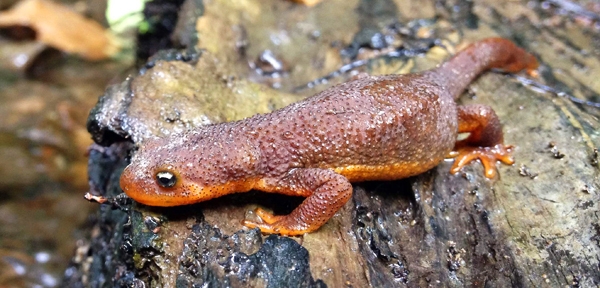Reposted from the Confluence, Blog of the California Institute for Water Resources
When we think water in California, we tend to think big: the Sacramento River, the American, the Delta. But, the state is also filled with small headwater streams that can be particularly easy to overlook when, during the state's dry summers, they start to resemble a series of pools rather than flowing creeks. Adding insult to injury is a longstanding view that the fish and insect communities in these intermittent streams will be less diverse than those found in the larger rivers they run into.
It is against this backdrop that scientists at the University of California, Berkeley, with support from the California Institute for Water Resources, set out to study some small creeks in the northern part of the state. They have been both surprised and excited by the diversity they are encountering. For example, at John West Fork in Marin County, they observed California giant salamanders, California newts, and Pacific chorus frogs, along with imperiled steelhead trout and coho salmon. In nearby Pine Gulch, they have observed a similar suite (minus the coho salmon), including several pools supporting older steelhead trout. The presence of these larger animals is an encouraging sign of resilience. They also found an abundant and diverse range of small invertebrates like mayflies, stoneflies, caddisflies—insects that are an important part of the food chain.
“These are small streams that lack flow for part or most of the year, yet they are totally filled with life. Understanding how these tiny little aquatic organisms manage to navigate this crazy and variable landscape, and thrive in conditions that most species would find very challenging, is really cool,” says project researcher Michael Bogan.

This finding is a great reward for difficult field work in a setting where streams can go from several months of dryness to raging flood waters with a single storm. “There's a lot of slogging up and down stream channels, crawling over downed trees & logs, sliding on wet rocks, and avoiding poison oak and stinging nettle,” says Bogan, though you mostly get the sense that he doesn't mind.

“In the long run, it's really exciting to think about how we can use this understanding of species ecology to inform water resource management and maximize our ability to support aquatic biodiversity and mindful agriculture and water use. In many situations, I do believe we can have the best of both worlds,” says Bogan.
The full study results are in: Bogan, Michael T., Jason L. Hwan, and Stephanie M. Carlson. In Press. High aquatic biodiversity in an intermittent coastal headwater stream at Golden Gate National Recreation Area, California. Northwest Science. Contact mbogan@berkeley.edu for a pre-press copy.
This research was supported in part through a grant to Principal Investigator Stephanie Carlson at the University of California, Berkeley from the California Institute for Water Resources in the University of California's Division of Agriculture and Natural Resources.
